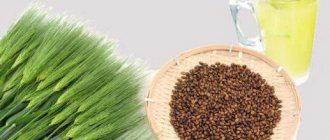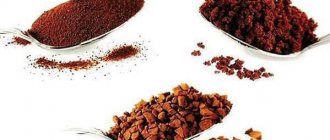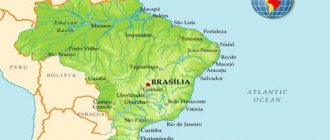Humanity has been cultivating barley for about 10 thousand years. This is one of the oldest cultivated cereals. It is mentioned in the Bible and Homer's Odyssey. A whole book could be written about the beneficial properties of the plant. We are used to thinking of cereals as porridge, pearl barley or barley. However, not only porridge is made from barley grains, but a drink that tastes like coffee. Cereal infusion differs from the latter in that it has practically no contraindications.
The benefits of such a drink are multifaceted and great. Normalizing weight, regulating blood glucose levels, strengthening the immune system, strengthening the heart and blood vessels, and the gastrointestinal tract - this is an incomplete list of the valuable properties of the product.
What kind of drink is this
An infusion of barley and rye is a coffee substitute . Let's find out what it is called in different countries. The word "mugitcha", or barley tea, comes from Japan, where an infusion of unrefined, roasted barley or wheat grains has long been known. In China the drink is called “damaicha”, in Korea it is called “porichha”. The taste of the product resembles Soviet coffee substitutes (ersatz coffee): for example, the “Summer” drink. In Russia, barley coffee also has its fans.
What is it made of?
Coffee substitute is prepared from roasted and finely ground barley beans . To highlight the taste of the drink, rye is added to it. It adds depth to the infusion and helps reveal the beneficial properties of the main grain.
There are different brands of the product on the market, most often in soluble or ground form. For variety, ground rose hips, chicory or even acorns are added to the barley.
Production
Drying and peeling of fruits
To begin with, the coffee beans are harvested, a process still done by hand. The fruit is then dried and peeled using one of two methods.
The dry method is a more ancient, primitive and labor-intensive process. The fruits are laid out in the sun and raked and spread out again several times during the day. When they dry out to the point that they contain only 12 percent water, the pavers become wrinkled. At this stage they are processed manually or by machine.
When using the wet method, the husks are removed before drying. The fruits are first processed in a pulping machine, which removes most of the material surrounding the beans, but some of this glue coating remains after the pulp is cooked. This residue is removed by adding enzymes in tanks where their natural enzymes digest the sticky substance over a period of 18 to 36 hours.
Once removed from the fermenting tank, the beans are washed, dried with hot air and placed in large mechanical mixers called hullers. Huller will polish the beans to a clean, glossy finish.
Cleaning and sorting beans
The beans are then placed on a conveyor belt, which carries them past workers who remove sticks and other debris. They are then graded based on the size, location and height of the plantation where they were grown.
Once these processes are complete, workers select and package specific types and grades of beans to fill orders from the various roasting companies that will complete the bean preparation. When beans (usually robusta) are harvested in undesirable conditions—hot, humid countries or coastal areas—they should be shipped as quickly as possible, as such climates are conducive to insects and fungi that can seriously damage the cargo.
When the coffee beans arrive for roasting, they are again cleaned and sorted using mechanical devices to remove leaves, bark and other remaining debris. If the beans are not supposed to be defatted, they are ready to be roasted.
Decaffeination
If coffee can be defatted, this is done using two methods. The first is using a solvent, the second is called aqueous.
In the first process, coffee beans are treated with a solvent (usually methylene chloride) that leach out the caffeine. If this degreasing method is used, the beans must be thoroughly washed to remove any traces of solvent before roasting.
The water method involves steaming the beans to bring the caffeine to the surface and then scraping off that caffeine-rich layer.
Burning
The beans are roasted in huge commercial roasters according to procedures and specifications that vary between manufacturers (specialty shops typically buy the beans directly from the growers and roast them on site). The most common process involves placing the bean in a large metal cylinder and blowing hot air into it. An older method called staggering requires placing the beans in a metal cylinder, which is then rotated over an electric, gas or coal heater.
Regardless of the method used, roasting gradually raises the temperature of the beans to 220-230 degrees Celsius. This causes the release of steam, carbon monoxide, carbon dioxide and other volatiles, reducing the weight of the beans by 14 to 23 percent. The pressure of these escaping internal gases causes the beans to swell, increasing their volume by 30 to 100 percent. Roasting also darkens the color of the beans, gives them a crumbly texture, and causes chemical reactions that imbue the coffee with its familiar aroma (that it has not yet possessed).
After roasting, they are placed in a cooling vessel in which they are mixed while cold air blows on them. If the brewed coffee is of high quality, the cooled beans will now be sent through an electronic sorter equipped to detect and eliminate beans that come out of the roasting process too light or too dark.
If the coffee is pre-prepared, the manufacturer injects it immediately after roasting. Special grinding types have been developed for each of the different types of coffee makers, as each is best suited for coffee of a certain fineness.
Instant coffee
If coffee must be instant, then it is brewed using water in huge percolators. The extract is purified from the brewed coffee and sprayed into a large cylinder. As it falls down through this cylinder, it enters a warm air stream that turns it into a dry powder.
Package
Whole coffee beans are less susceptible to loss of aroma and flavor than other types of coffee and are usually packaged in foil bags.
Pre-ground coffee should be hermetically sealed, as it retains its basic qualities less well. It is usually packaged in impermeable plastic film, aluminum foil or cans.
Instant coffee easily absorbs moisture, so it is vacuum packed in tins or glass jars before shipping to retail stores
Making coffee video
Taste and smell
Connoisseurs of natural coffee claim that the barley drink does not resemble it in any way. The taste is really different, but it has its advantages. Compared to the original composition, the barley infusion has a milder taste, without bitterness . The light bready aroma gives the drink its originality and does not spoil it at all.
The various additives that manufacturers use (acorns, rose hips, finely ground rye) add a unique flavor. The maximum similarity to coffee is achieved by mixing barley and chicory.
By the way! Cappuccino lovers will love barley coffee with milk.
Composition and properties
The barley drink has a rich composition.
Microelements:
- iron;
- fluorine;
- manganese;
- copper.
Macronutrients:
- sodium;
- sulfur;
- calcium;
- magnesium;
- chlorine.
The calorie content of 100 g of drink (10 g of barley extract per 200 ml of water) is 14–20 kcal. Contents of the BZHU:
- proteins - 1 g;
- fats - 0 g;
- carbohydrates - 3 g.
Interesting things on our website:
Simple recipes for barley moonshine
How to make malt from barley
How to make moonshine from rye
Benefits and harms
Let's figure out what benefits and harms a coffee drink made from barley and rye brings.
Cereal infusion is used for:
- diabetes mellitus - barley coffee keeps glucose levels from jumping, fiber slows down the rate of glucose absorption;
- diseases of the gastrointestinal tract - the infusion restores the epithelial tissue lining the organs, which increases the number of beneficial bacteria and improves the functioning of the gastrointestinal tract;
- problems with blood vessels and heart - the cereal drink saturates the body with magnesium and potassium, which reduce high blood pressure and strengthen the walls of blood vessels;
- excess weight - the product stabilizes body weight, as it unloads the pancreas (the glucose entering it is completely decomposed and does not go to build fat deposits).
This is interesting! Rye-wheat drink tones and restores strength. Therefore, it is recommended for use after surgical interventions and protracted illnesses.
Cereal coffee can have harmful effects if improperly prepared or abused. The average daily norm is no more than 4-5 cups of drink. With a larger amount, the weight loss effect changes to the opposite.
BENEFITS OF BARLEY DRINK || Coffee substitute
Making your own cereal coffee
There are many instant and ground varieties of barley drink on store shelves . The first is enough to fill with hot water, add sugar, milk, cream if desired. The second boil and insist.
What and how to cook from
For cooking, take 3 tbsp. l. barley and rye .
The largest grains are chosen, without signs of spoilage or mold. They are washed thoroughly until the water turns clear. The second step is fermenting the grain. This procedure gets rid of phytic acid in cereals, which leads to mineral deficiency. To do this, the grains are completely filled with water and left for a day. Afterwards, the liquid is drained, fresh is added and boiled until the cereal shell bursts.
The next stage is washing the raw materials and frying them in a dry frying pan. It is important here to prevent the beans from burning, otherwise the coffee will be bitter and will not please you with its delicate taste. The roasted grain is ground in a coffee grinder or blender.
When making a drink at home, you choose the degree of roasting yourself and add additional ingredients.
Cooking recommendations
After the brewing mixture is ready, take 150 ml of water and 1 tbsp. l. with a pile of received raw materials . The composition is brought to a boil and boiled over moderate heat for 2 minutes, then infused for the same amount. Instead of 1/3 of water, you can add milk, then the taste will be similar to cappuccino. 1 tsp. chicory in the composition will make the taste and color of the product more saturated and add a piquant note.
By the way! To make a coffee drink taste sweet, sugar is added to it, but such sweetening reduces the beneficial qualities of coffee. Therefore, sugar is replaced with honey, stevia or natural syrups.
Methods for making barley coffee
You can roast barley for coffee yourself; to do this, the grains are first washed and dried.
There are two cooking methods:
- in the oven at a temperature of 170-180 °C;
- in a frying pan over low heat.
To ensure even frying, shake the pan periodically, trying to avoid burning. The finished product is characterized by an amber color and the smell of fresh baked goods. The barley is then ground in a coffee grinder. The powder does not tolerate high humidity, so it is recommended to use it immediately and not make reserves for future use.
Brewing recipes
- Pour 3 teaspoons of powder into a glass of water, bring to a boil in a pot, add sugar.
- Dilute 150 ml of whole milk with half and half water, put on fire, bring to a boil, add 5 teaspoons of ground barley, cook for 2-3 minutes.
- Heat a ceramic cup, add 3 teaspoons of barley powder and sugar to taste. Pour in a small amount of hot water, stir, top up, close with a lid and let stand for 4-5 minutes.
You can safely experiment with the drink - add honey, syrup, lemon or ice cream. To give coffee a rich color and aroma, barley is mixed with chicory.
Ready drink
By buying ground or powdered rye-barley coffee, you will get rid of the hassle of preparing it. The ground cereal product is brewed as in the recipe above . Instant is poured with hot water or milk.
Review of popular brands
Popular brands of instant barley drink:
- “Health” : the flavor palette is rich, delicate, similar to traditional coffee;
- “Ear of Barley” : this drink is distinguished by a light bready taste, smell and delicate foam that rises after brewing;
- “Old Mill” : the taste of cereals is practically not felt, there are soft coffee notes.
Contraindications
The drink has no special contraindications, other than individual intolerance to grains . No side effects have been identified from its use.
Due to the presence of protein in this coffee, it is undesirable to drink if you have kidney diseases. Excessive consumption contributes to weight gain.
Is it possible during pregnancy?
There are no objective contraindications to drinking the drink during pregnancy and breastfeeding . However, before introducing cereal coffee into your diet, it is important to consult your doctor.
With the permission of the pediatrician, a nursing mother can gradually introduce the product into the diet, carefully monitoring the child’s condition and the absence of an allergic reaction.
Important! The main rule that pregnant and nursing mothers should follow is moderation. Do not overuse the coffee drink if you like it. Limit yourself to 2-3 cups. This is the optimal dose for the benefit of the body.
What is coffee made from?
Coffee is made from the seeds or beans of the coffee tree. Coffee beans contain more than 100 chemicals, including aroma molecules, proteins, starches, oils, and bitter phenols (acidic compounds), each of which has its own distinct, unique coffee flavor. The coffee tree, a member of the evergreen family, has waxy, pointed leaves and jasmine-like flowers.
Actually more like a shrub, the coffee tree can grow up to 9 meters in its wild state, but is usually pruned to between 1.5 and 3.5 meters when cultivated. Once planted, a typical tree will not produce coffee beans until it flowers, a process that typically takes about five years.
After the white petals fall off, red fruits appear, each containing two green coffee beans. Industrial production of beans requires a large number of trees: in one year, 400-500 grams of coffee can be harvested from a small bush. Because coffee cherries ripen unevenly, harvesting requires careful selection of only red ripe berries: including unripe green ones and overly ripe black ones will affect the taste of the coffee.
Coffee trees grow best in temperate climates without frost or high temperatures. High altitude plantations, located between 900 and 1800 meters above sea level, produce low-moisture beans with great flavor. Due to the positive influences of volcanic soil and altitude, the finest beans are often grown in mountainous areas. Today Brazil produces about half of the world's coffee. One quarter is produced in other Latin American countries, and Africa accounts for about one-sixth of global supply.
There are currently about 25 species of coffee trees, determined by environmental factors such as soil, weather and altitude. The two main species are coffea robusta (robusta) and coffea arabica (arabica). The Robusta strain produces less expensive beans, mainly because it can be grown in less ideal conditions than the Arabica strain. When served, coffee made from Arabica beans has a deep reddish hue, while Robusta beans have a dark brown or black appearance.
Coffee made from two main components is significantly different. Robusta beans are typically grown in large plantations where the berries are ripened and harvested at one time, thereby increasing the percentage of under-ripe and over-ripe beans. Arabica beans, on the other hand, include the bulk of premium coffee, which are typically sold as a whole bean so customers can grind their own coffee. Whether in a cafe or brewed at home, coffee made from these beans has a more subtle and less acidic taste.
Reviews
Those who tried the drink liked it. The beneficial properties of the infusion are especially :
Natalya, 26 years old : “I really love coffee, but during pregnancy I had to give it up: the doctor forbade it. A friend advised me to switch to cereal coffee. I tried it. At first the taste was a little unusual, but then I liked it. I drank it morning and evening throughout my pregnancy and after the baby was born. I didn’t find any allergies or other negative effects on the child.”
Rosa, 30 years old : “A coffee drink made from oats and barley is just a godsend for me. Thanks to its regular use, the functioning of the gastrointestinal tract has improved and constipation has gone away. Even my figure became slimmer. I drink 3-4 cups a day with milk.”
Sergey, 47 years old : “Because of high blood pressure, I don’t drink coffee anymore, although I like it. While looking for an alternative, I came across a barley-rye drink. I really liked it. To maximize the similarity, I add instant coffee to the mug, literally at the tip of a knife. Tasty and healthy."
Raw materials and production process of natural coffee
Coffee beans grow on coffee trees, mainly only in warm countries - in the so-called coffee belt of the Earth.
The raw materials for the production of natural coffee are coffee beans. They grow on coffee trees, which belong to the madder family. Among their representatives there are about 60 types of coffee.
But today, only two varieties of grains are used. These are Arabica and Robusta trees. The fruits of the former have lower caffeine content, but they are rich in aromatic oils.
Only two varieties of beans are used: Arabica and Robusta.
Depending on the type of coffee drink, the production technology also changes. Ground is made as follows:
- after assembly, the grains are cleaned of foreign impurities;
- using special equipment, the husks are removed;
- the fruits undergo wet processing - washing;
- green grains undergo a fermentation process, during which work on residual purification occurs;
- drying the grains.
An important processing process is the roasting of coffee beans.
Wet processing of raw materials lasts no more than 24 after the beans have been collected. Compliance with this point affects the taste of the finished product. Next, the fruits of the coffee tree are roasted (undergo heat treatment). And at the final stage - grinding.
Granulated coffee consists of coffee particles that form lumps under the influence of steam.
Granulated coffee is coffee particles that, under the influence of steam, have turned into small lumps.
Process of making granulated coffee:
- in their raw form, the grains undergo a cleaning process;
- fried;
- crushed into small particles (their size reaches 2 mm or less);
- Due to the pressure of a stream of hot water, small soluble coffee particles are extracted. The raw materials are processed with hot water for 4 hours;
- This is followed by filtration, which removes unnecessary impurities. At the same stage, drying is carried out;
- humidification of ground particles with steam. It is at the moment of such processing that the coffee powder sets in the form of granules of arbitrary shape, but approximately the same size.
At the final stage, freeze-dried coffee is saturated with previously extracted essential oils
Freeze-dried coffee is made using a special technology that allows you to preserve all the important components that make up the product. At the first stages, the grains undergo the same processing system as in the previous version. They are cleaned, fried and crushed into small particles. Then there are completely different stages:
- ground coffee is scattered into separate containers and boiled for 3-4 hours;
- All essential oils are extracted from raw materials using special equipment;
- In special freezers, the remaining coffee mass is frozen. In this case, the freezing process occurs in such a way that the product is not saturated with moisture, but becomes as dry as possible;
- the dried mass is broken into small pieces that look like pyramids and fragments;
- At the final stage, the product is saturated with previously extracted essential oils.
If the coffee is really high quality, then natural oils are added to it. If the manufacturer is not very concerned about this point, he can use oils of synthetic origin.











